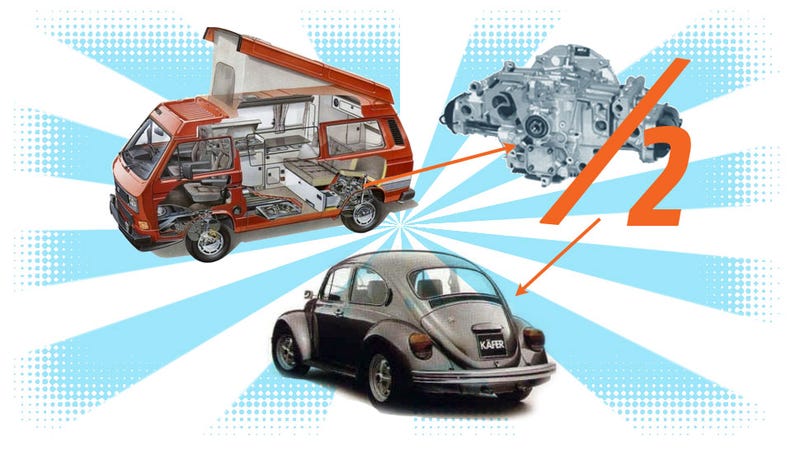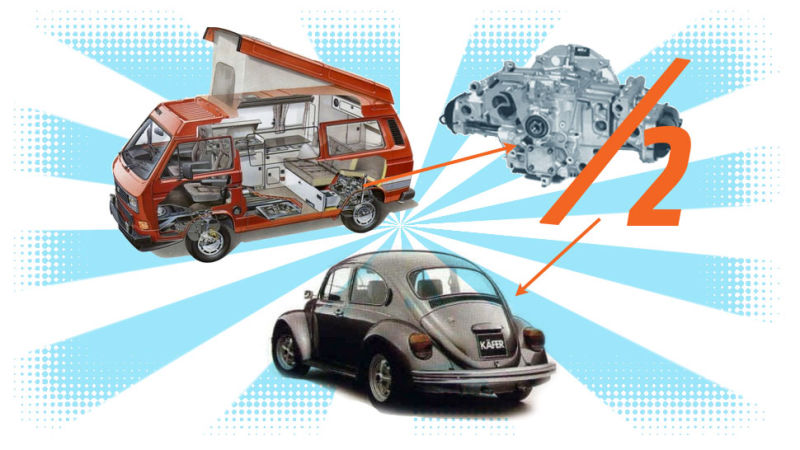
I never really thought a car as comprehensively and exhaustively explored, scrutinized, and fetishized as the Volkswagen Beetle could possibly have anything that would surprise me here in this futuristic year of 2016, but I was wrong. So wrong. Because I’ve just learned some almost 30-year old VW news that’s blowing my mind-grapes.
The news comes from a little report from 1989, re-published on an Australian VW enthusiast group’s website. I think the original story was in one of their printed newsletters. Anyway, the story describes something I had no idea existed: intensive Volkswagen factory effort put into Beetle/Type I engine development as late as 1985.
I had always thought that once the water-cooled, FWD VWs like the Golf and Passat came on the scene, development of the old Type I platform was sort of mothballed, limited to minor incremental and compliance-related updates for their remaining Mexican and Brazilian markets.
Advertisement
But this report suggests that a whole new engine development path was being considered that could have radically changed the Beetle, and possibly could have given it a bit longer life, if successful.
That development was based on the use of the somewhat infamous Wasserboxer engine in the Beetle.
Sponsored
The Wasserboxer engine was a water-cooled variation of the old air-cooled flat-four engine (get it? Water-boxer? Wasserboxer?)first developed way back in the ‘30s, the engine that had been the prime mover of millions and millions of Beetles, Buses, Ghias, Things, and so much more.
The Wasserboxer was only used in the VW Type 2 from 1982-1992. Here in the US, we had these engines in Vanagons, and they don’t have the best reputation, but they do have a sort of cult following.
The Wasserboxer saga is a story of its own, but for here we’ll just say that, ideally, a water-cooled design let VW get a bit more power and better emissions from the old design.
But now for the radical part: I had no idea VW ever seriously considered a Wasserboxer in a Beetle. What’s really crazy is that this report – and these crappy pictures – show that they even considered half a Wasserboxer for the Beetle.
Advertisement
That’s already delightfully weird, but even better is who Volkswagen hired to help cut that engine in half and shove it in a Beetle: Cosworth Engineering. Interestingly, the VW Group bought Cosworth in 1998.
Here’s what that 1989 report says of the half-Wasserboxer effort:
The last intensive factory engine development for the Beetle was carried out in 1985, though we never saw the results, unfortunately. The British firm, Cosworth, was given the job of cutting a 1900cc Wasserboxer engine in half and installing it in the back of a Mexican Beetle. Don’t forget that the four-cylinder motor as we know it appeared in the Transporter for the first time in 1983.
Instead of the obvious, but expensive path of installing the radiator in the front of the car, it was mounted over the motor immediately in front of the engine lid. Access to the engine was gained by hinging the radiator to the side. Must have had some pretty fancy swiveling seals to be able to do that. The water-cooled twin had a capacity of 950cc and delivered 25kW to the ends of the swing axles. Hardly enough to satisfy the wishes of most customers, even in those days, so it wasn’t a goer.
Wow. That radiator mounting system seems bonkers, though it does have some advantages. Where the Wasserboxers in the buses had to have a jacuzzi’s worth of plumbing to pump water from the front to the way back of the bus, that goofy hinged radiator would have kept all those hoses and water lines nice and short, and would require less body changes to the front of the car.
Sure, 33 HP is pretty crappy, and I’m sure nobody in VW’s PR team wanted the job of spinning a 10+ HP loss as a Fantastic New Feature if VW went this route.
Since the 950cc flat-twin wasn’t gutsy enough, they did try a whole Wasserboxer in a Super Beetle:
Next thing they tried in Wolfsburg was to bolt in a complete 1900cc motor into a Beetle. The more capable strut-front-ended and CV-joint rear-ended Superbug was chosen, since the motor was too powerful for the VW 1200, the only Type 1 under construction by that time. The experiment was judged a success, and the Wolfsburg engineers were very enthusiastic about the power developed. However, it had to remain an experiment, as the Superbug (1303S) was long out of production, having last been produced (as a non-Cabrio) in 1975.
Now this, this is a very exciting idea. I don’t really get why VW thought they needed the McPherson strut front suspension for this, since high-HP standard Beetles have been built by regular dipshits for decades.
Still, the idea that a rear-engined, boxer, water-cooled Beetle making 90 or more HP could have existed in the 1980s and 1990s is a deliriously appealing idea, even if I know that realistically, there’s all sorts of reasons why it never would have happened, and even if it did, it probably wouldn’t have made it to Americaland.
I’ve contacted Volkswagen’s Heritage division to try and get some corroborating proof of these exciting experiments; if they manage to find anything, I’ll be sure to update accordingly.
In the meantime, I’ll daydream about what could have been, geekily.















